Section III of the flight logs is entitled "Daily Flight Operations Record." With this section, we get to the heart of the matter because, in addition to the usual information, a brief mention is made about the missions flown. Most of the information lacks precision or details, but it is sometimes possible to read between the lines.
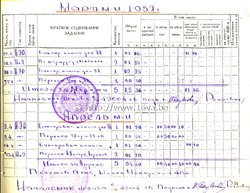
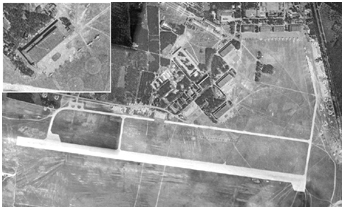 The first flights do not take place until March 1952. Berezin flies three times in an A-20 and two times in a Po-2. Two of the Boston flights involve towing a target (a cone)
for interaction with the antiaircraft artillery (AAA) (1). The other flights are vague: Exercise 25, Route 13...
The first flights do not take place until March 1952. Berezin flies three times in an A-20 and two times in a Po-2. Two of the Boston flights involve towing a target (a cone)
for interaction with the antiaircraft artillery (AAA) (1). The other flights are vague: Exercise 25, Route 13...
Three more flights with A-20s and two more in a Po-2 in April: two target-towing flights (AAA) and one training flight according to Exercise 25-18 for the A-20s; the Po-2 is used for
a transit flight between Altes Lager and Altengrabow and logically a second oncoming flight (only one mention of two flights in the flight log). It won't be the only flight to Altengrabow
as we will see. It should be noted that a grass airfield was set up on this training range near Schweinitz.
Another reserve runway was located at Lübars, but it would not have entered service until 1957.
But what was in Altengrabow? The Altengrabow Combined Artillery Training Camp (Al'tengrabovskiy Obedinennyy Uchebnyy Artilleriyskiy Lager' - FPN 68083) and the
Altengrabow Anti-Aircraft Artillery Training Range Directorate (Upravleniye Al'tengrabovskogo Uchebnogo Zenitno-Artilleriyskogo Poligona - FPN 68087). This gives some credence to
the presence of FPN 68083 in Berezin's flight log.
In fact, small target towing units were attached to larger units like a squadron or a regiment purely for logistical reasons. They did not have their own maintenance section
(TECh - Tekhniko-Ekspluatatsionnaya Chast') or their own aerodrome support company (ORATO - Otdel'naya Rota Aerodromno-Tekhnicheskogo Obespetcheniya).
However, these separate squadrons (OAE), flights (OBAZ - Otdel'noye Buksirovochnoye Aviatsionnoye Zveno) and detachments (OBAO - Otdel'nyy Buksirovochnyy Aviatsionnyy Otryad)
were not subordinate to the parent unit providing their logistics (the squadron or the regiment); they were assigned either the FPN of the parent unit plus the letter A, or the FPN of the unit
to which they were directly subordinate. Thus, the target towing section of the 931.OKRAP was subordinate to the Altengrabow Combined Artillery Training Camp whose FPN was 68083.
It is in any case what appears clearly in Berezin's flight log from 1954.
The month of May is very quiet with only three flights: on the 7th, an A-20 night sortie and, on May 21, two target-towing sorties (without further details), again in a Boston.
No flights in June and July, but six target-towing flights - including one at night - in A-20s in August.
Thirteen flights in September, all in A-20s. All of them consist of target-towing, but it must be noted that there are eight - among them one at night - "en route" and five "circuit flying" (four on 5 September)
i.e. presumably around or near the airfield as that can be read in some CIA reports.
Five flights in October. Two local flights in a Po-2, two flights according to Exercise 18 in an A-20 and a navigation flight in a Boston.
Eleven Po-2 flights in December, three of them at night. One of the missions is a day reconnaissance training flight (probably for artillery fire adjustment or spotting).
Section II of the flight log mentions the total flights made in 1952 (> Link): 48 flights in 50 hours and 38 minutes.
The flights are divided into 28 day flights and 3 night flights in A-20s, plus 14 day flights and 3 night fights in Po-2s. At the end of each month in Section III, the seal of FPN 42004 is applied and the
document is signed by Guards Lieutenant Colonel Reutovich, Chief of Staff of FPN 42004.
On the other hand, Matyunin flew 113 times in 1952, spreads over 69 flights with Il-2s, and 31 flights with Po-2s by day and 13 by night in 76 hours and 7 minutes.
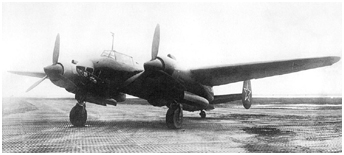 January 1953 does not reflect anything about the future: five Po-2 flights, including four at night "in the zone" on the 23rd.
No flights in February, but two flights in a Po-2 at the end of March (round trip flights to Altengrabow) and especially nine flights with Tu-6s, including five spread over two days on the 6th and 8th
(day circuits according to conversion Exercise 8) and a navigation flight on the 17th. The next day, a liaison flight takes place between Schönwalde and Stendal and, two days later, between Stendal and Altes Lager.
More trips to Stendal are flown during the year.
This is because only the tow aircrafts and a few Po-2s are based at Altes Lager, while the other aircraft of the unit are at Stendal. The squadrons stationed at this latter airfield joined Zerbst in 1954,
while the detachment of Altes Lager did not relocate until the end of 1955.
A last interaction flight with the AAA on the 25th (presumably, the aircraft serves as a target for AAA gunners who train to acquire and track it) completes the Tu-6 chapter of the month. Berezin won't fly with A-20s anymore.
Therefore, it is clear that the Tu-6s replaced the Bostons.
January 1953 does not reflect anything about the future: five Po-2 flights, including four at night "in the zone" on the 23rd.
No flights in February, but two flights in a Po-2 at the end of March (round trip flights to Altengrabow) and especially nine flights with Tu-6s, including five spread over two days on the 6th and 8th
(day circuits according to conversion Exercise 8) and a navigation flight on the 17th. The next day, a liaison flight takes place between Schönwalde and Stendal and, two days later, between Stendal and Altes Lager.
More trips to Stendal are flown during the year.
This is because only the tow aircrafts and a few Po-2s are based at Altes Lager, while the other aircraft of the unit are at Stendal. The squadrons stationed at this latter airfield joined Zerbst in 1954,
while the detachment of Altes Lager did not relocate until the end of 1955.
A last interaction flight with the AAA on the 25th (presumably, the aircraft serves as a target for AAA gunners who train to acquire and track it) completes the Tu-6 chapter of the month. Berezin won't fly with A-20s anymore.
Therefore, it is clear that the Tu-6s replaced the Bostons.
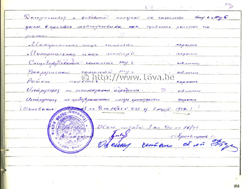
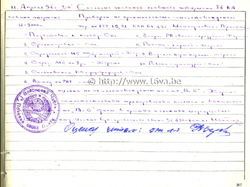 Section VII entitled "Testing of Airmanship and Combat Employment Methods" specifies the holder's qualifications on combat aircraft or their training version. It shows the skill level of the holder
in different subjects such as visual or instrument flight, the use of special equipment, etc. Thus, we learn that Berezin was trained with the unit whose FPN was 36706 (i.e. the 48.OGRAP based at Schönwalde)
in order to be able to fly spotter missions with UTu-6 and Tu-6 aircrat. His assessment was described as "good" in terms of airframe and engine, special equipments, armaments, flight zone, airfield procedures
and instructions to prevent loss of orientation as of March 5, 1953. The assessment was marked as read by an officer of the 931.OKRAP, but it was the seal of FPN 36706 that was applied at the bottom of the page.
From the above, it can therefore be argued that the flights carried out before the 18th were flown from Schönwalde as part of the aircrews conversion program to the Tu-6. This little-known aircraft was actually a version of
the Tu-2 very difficult to identify and the agents responsible for informing the Western intelligence services probably never distinguished one version from the other. From 1944 on, some Tupolev Tu-2 production lots had
the option to mount an additional fuel tank and cameras in the bomb bay. These aircraft were unofficially designated Tu-2R. But a version of the Tu-2 dedicated to reconnaissance was developed at the end of
the war and the series-produced aircraft were designated Tu-6 in 1947. The 48.OGRAP would have arrived at Schönwalde in October 1951, while the Il-10 of the 710.GvShAP and the Pe-2 and Tu-2 (Tu-6?) of the 886.ORAP
that had previously occupied the airfield had departed to Stendal (October) and Oranienburg (June, for conversion to the Il-28 with the 24.BAP of the 240.BAD), respectively. CIA reports state that the 48.OGRAP's strength
comprised about 15 Tu-2s - but they were actually Tu-6s. The latter repeatedly mentioned that the unit equipped with the "Tu-2" was towing targets. The fact is that "..."Tu-2s" were occasionally observed towing air sleeves
near various 24th Air Army airfields..." Therefore, it is very likely that the 48.OGRAP also practiced this discipline.
Section VII entitled "Testing of Airmanship and Combat Employment Methods" specifies the holder's qualifications on combat aircraft or their training version. It shows the skill level of the holder
in different subjects such as visual or instrument flight, the use of special equipment, etc. Thus, we learn that Berezin was trained with the unit whose FPN was 36706 (i.e. the 48.OGRAP based at Schönwalde)
in order to be able to fly spotter missions with UTu-6 and Tu-6 aircrat. His assessment was described as "good" in terms of airframe and engine, special equipments, armaments, flight zone, airfield procedures
and instructions to prevent loss of orientation as of March 5, 1953. The assessment was marked as read by an officer of the 931.OKRAP, but it was the seal of FPN 36706 that was applied at the bottom of the page.
From the above, it can therefore be argued that the flights carried out before the 18th were flown from Schönwalde as part of the aircrews conversion program to the Tu-6. This little-known aircraft was actually a version of
the Tu-2 very difficult to identify and the agents responsible for informing the Western intelligence services probably never distinguished one version from the other. From 1944 on, some Tupolev Tu-2 production lots had
the option to mount an additional fuel tank and cameras in the bomb bay. These aircraft were unofficially designated Tu-2R. But a version of the Tu-2 dedicated to reconnaissance was developed at the end of
the war and the series-produced aircraft were designated Tu-6 in 1947. The 48.OGRAP would have arrived at Schönwalde in October 1951, while the Il-10 of the 710.GvShAP and the Pe-2 and Tu-2 (Tu-6?) of the 886.ORAP
that had previously occupied the airfield had departed to Stendal (October) and Oranienburg (June, for conversion to the Il-28 with the 24.BAP of the 240.BAD), respectively. CIA reports state that the 48.OGRAP's strength
comprised about 15 Tu-2s - but they were actually Tu-6s. The latter repeatedly mentioned that the unit equipped with the "Tu-2" was towing targets. The fact is that "..."Tu-2s" were occasionally observed towing air sleeves
near various 24th Air Army airfields..." Therefore, it is very likely that the 48.OGRAP also practiced this discipline.
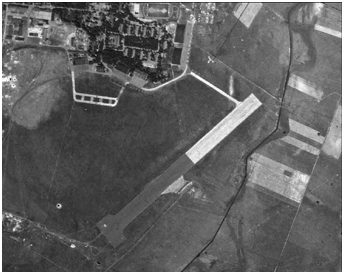 The regiment had left Schönwalde in mid-1953 a priori for Welzow (2) before moving to Kolomyya (Ukrainian SSR) that year. Thus, Berezin was evaluated shortly before
the departure of the 48.OGRAP. On the other hand, a CIA report from January 1954 (not 1953 as stated > Link) states:
"... The tow-target unit transferred [to Welzow] in May 1953, while, apparently simultaneously, the air units were detached to various fighter divisions for target representation;
this is confirmed by the appearance of Tu-2s at Jueterbog [Altes Lager] and Puetnitz [Damgarten] airfields." The presence of these Tu-6s at Altes Lager - the base of the 931.OKRAP - and Damgarten corresponds
well to Berezin's flight log. It is therefore reasonable to assume that the Tu-6s of the 931.OKRAP were former aircraft of the 48.OGRAP.
The regiment had left Schönwalde in mid-1953 a priori for Welzow (2) before moving to Kolomyya (Ukrainian SSR) that year. Thus, Berezin was evaluated shortly before
the departure of the 48.OGRAP. On the other hand, a CIA report from January 1954 (not 1953 as stated > Link) states:
"... The tow-target unit transferred [to Welzow] in May 1953, while, apparently simultaneously, the air units were detached to various fighter divisions for target representation;
this is confirmed by the appearance of Tu-2s at Jueterbog [Altes Lager] and Puetnitz [Damgarten] airfields." The presence of these Tu-6s at Altes Lager - the base of the 931.OKRAP - and Damgarten corresponds
well to Berezin's flight log. It is therefore reasonable to assume that the Tu-6s of the 931.OKRAP were former aircraft of the 48.OGRAP.
Tu-6 missions continued at the 931.OKRAP with two interaction sorties with the AAA during the month of April, but nothing in May and June.
July is more active and begins with two flights in a Po-2 for a round trip between Altes Lager and Stendal. Then, no less than 23 flights are made in Tu-6s. Two missions a day are carried out six times
and three daily missions three times. Three cooperation target-towing flights for the AAA took place. Ten local-area sorties are flown including nine by night. Two other night sorties involve navigation flights.
Six flights are for target-towing without further details. The month ends with two night target-towing flights and circuits.
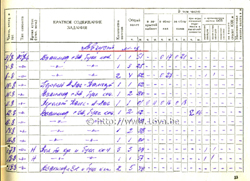
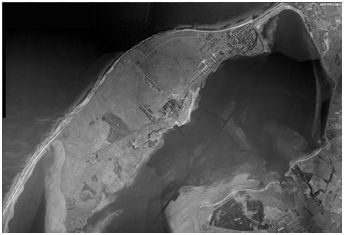 The number of sorties peaks in August with no less than 30 flights - 28 in Tu-6s and 2 in a Po-2 (again a round trip between Altes Lager and Stendal).
The month begins with four target-towing flights (AAA interaction). On the 10th, a transit flight takes place between Altes Lager and Damgarten, while another target-towing flight (AAA interaction) is conducted the same day.
This is clearly a mission to the Wustrow Firing Range (Wustrow in 1952 - > Link). Flight back to Altes Lager the next day.
Eight other target-towing missions (AAA interaction) are carried out during the month without further details. Four night flights consist of towing targets and flying in the circuit. A target-towing flight (AAA interaction)
also takes place at night. Three unspecified flights on the 24th and a Stendal-Altes Lager liaison flight on the 25th. The next day, new flight between Altes Lager and Damgarten, target-towing (AAA interaction) on August 27
and 28 (Wustrow) and return to Altes Lager on the 29th (increased activities of the Tu-6s in July / August mentioned in a CIA report. However, the aircraft are this time designated Pe-2s
> Link).
Twelve target-towing flights (AAA interaction), including one at night, are carried out with Tu-6s in September.
No less than fourteen flights take place in October, but with Po-2s (circuits and flights in the area).
Only one area flight is carried out in a Po-2 for the last month of the year.
The number of sorties peaks in August with no less than 30 flights - 28 in Tu-6s and 2 in a Po-2 (again a round trip between Altes Lager and Stendal).
The month begins with four target-towing flights (AAA interaction). On the 10th, a transit flight takes place between Altes Lager and Damgarten, while another target-towing flight (AAA interaction) is conducted the same day.
This is clearly a mission to the Wustrow Firing Range (Wustrow in 1952 - > Link). Flight back to Altes Lager the next day.
Eight other target-towing missions (AAA interaction) are carried out during the month without further details. Four night flights consist of towing targets and flying in the circuit. A target-towing flight (AAA interaction)
also takes place at night. Three unspecified flights on the 24th and a Stendal-Altes Lager liaison flight on the 25th. The next day, new flight between Altes Lager and Damgarten, target-towing (AAA interaction) on August 27
and 28 (Wustrow) and return to Altes Lager on the 29th (increased activities of the Tu-6s in July / August mentioned in a CIA report. However, the aircraft are this time designated Pe-2s
> Link).
Twelve target-towing flights (AAA interaction), including one at night, are carried out with Tu-6s in September.
No less than fourteen flights take place in October, but with Po-2s (circuits and flights in the area).
Only one area flight is carried out in a Po-2 for the last month of the year.
According to Section II of the flight log, 1953 ends with 104 flights in 118 hours and one minute (> Link).
This will be Berezin's most active year in the GDR. But only a hundred flights are actually carried out according to the calculation month by month, i.e., 55 day flights (instead of 56) and 19 night
flights in Tu-6s, as well as 22 day flights (instead of 25) and 4 night flights in Po-2s.
At the conclusion of each month in Section III, the seal of FPN 42004 is applied and the document is signed by Guards Lieutenant Colonel Reutovich, Chief of Staff of FPN 42004.
Matyunin flew 70 hours and 26 minutes in 85 flights, of which 56 were with Il-2s, 9 with Po-2s by day and 20 by night.
notes
(1)
We find in the flight log several standardized mentions to evoke the target-towing missions or those carried out for the AAA:
- "Target-towing." In the absence of further details, three hypothesis are possible: either a simple target-towing training flight, a target-towing
flight for the AAA or for the fighters. We will keep it as stated.
- "AAA Interaction and target-towing." So, presumably AAA is firing on the target. We will write "Target-towing (AAA)."
- "AAA Interaction." Here, the aircraft would only be used to train AAA personnel to track a target. We will write "cooperation [or collaboration]
with AAA."
(2)
CIA reports mention Welzow with uncertainty; however, a video (> Link) shot in the regimental museum reveals a map showing the combat
path of the unit passing through Schönwalde and Welzow. The possibility exists that the pilots first passed through Oranienburg for their
conversion to the Il-28 before joining Welzow, and then Kolomyya. We can see in the same video the silhouette of a Tu-6 on the route between
Schönwalde and Neu-Welzow and the silhouette of an Il-28 between Welzow and Kolomyya.
 |
Flight Logs < Part 1 | < Part 2 | > Part 4 | > Part 5 | > Part 6 |
 |
Plan du site - Sitemap |  |
